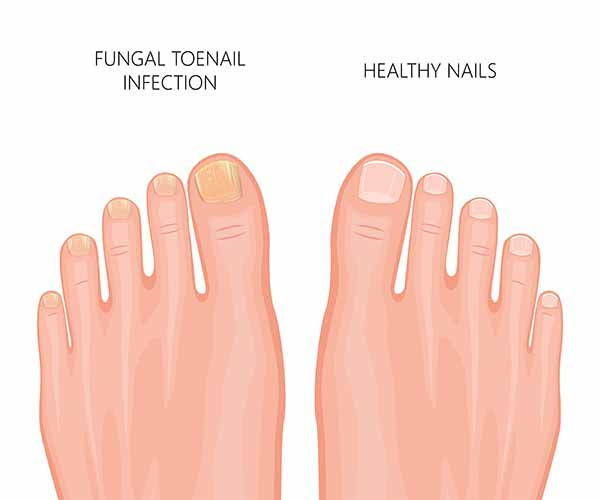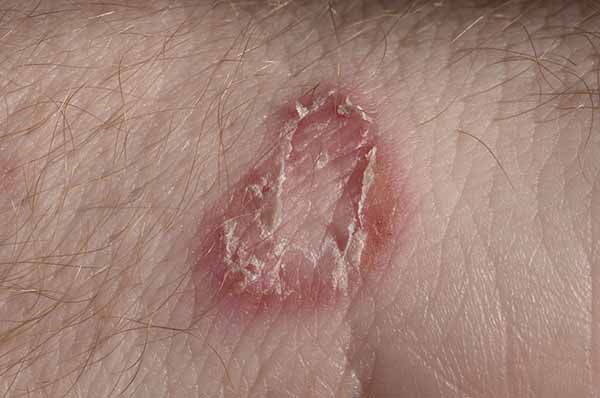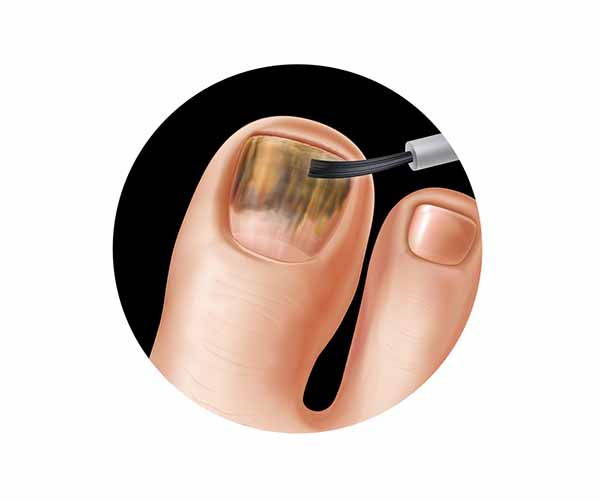Mycoses are infections that can affect the nails, skin, hair and mucous membranes such as the mouth or vagina. What are the causes and how are they treated naturally?
Don't store avocado like this: it's dangerousLe mycoses are infections fungal that can affect not only the nails, but also the skin, hair and mucous membranes such as the mouth or vagina. They spring from pathogenic fungi and are generally associated with the use of antibiotics, to a inefficient immune system or in the presence of diabetes. But what are the causes of a mycosis? And which ones typology and treatments with natural methods?
Based on the level of penetration, the spread of the infectious agent in the tissues and the specific characteristics of the microorganism, the human mycosis can be divided into four groups. The most common are the superficial infections and subcutaneous infections, while the best known of the cutaneous mycoses is the so-called athlete's foot (ringworm pedis), caused by a fungus present between the toes.
Index
What is mycosis and types of mycosis
With mycosis - from the Greek "mikòs", mushroom - it indicates a 'fungal infection, i.e. caused by pathogenic fungi. These are eukaryotic organisms, unicellular or multicellular, which can cause - as the word itself says - a certain pathology in humans, animals and plants (an example above all is candida).
They may affect the skin, the game, nails or mucous mouth and vagina and are classified into four types, based on the level of penetration and diffusion of the fungus in the tissues and its characteristics.
Superficial mycoses
They are diseases caused by fungi that they grow only on the surface of the skin and hair or hair, with a poor inflammatory response on the part of the normal host and therefore almost no immune response. In immunocompromised subjects (such as an HIV + subject) the spread of the fungus on the skin can be pathological, very extensive and with devastating results. When the infection mainly affects the nails, hands or feet, it is called onychomycosis (or tinea unguium).
Among examples the most frequent are:
- Pitiriasi versicolor (fungal factor: Malassezia furfur), which causes hyperpigmentation or hypopigmentation of the skin and mainly affects the chest, neck, back and shoulders
- Pitiriasi nera o tinea nigra (fungal factor: Hortaea werneckii), non-contagious, characterized by irregular and often isolated skin spots, brown or black and located mainly on the palms of the hands and soles of the feet
- Black stone (fungal factor: Pietraia hortae), uncommon but particularly widespread in tropical areas of Africa and South America, affects the hair shaft and is characterized by the formation of brown / black nodules on the scalp
- White stone (fungal factor: Trichosporon spp.), for which small rounded and white nodules are formed, in the hair and between hairs of the groin and armpits
Cutaneous mycoses
They are generally identified with the term of The beams. In this case, fungal growth occurs in the keratinized and deeper layers of the skin, hair, hair and mucous membranes. Unlike superficial mycoses, cutaneous mycoses lead to one immune response and the degradation of the epidermal layers of keratin. This in turn leads to irritation, inflammation and, in some cases, even allergic reactions.
Among examples the most frequent of cutaneous mycoses include:
- Piede d'athlete (fungal factor: Trichophyton mentagrophyes), affects the area between the toes and is manifested by red, itchy skin resulting in peeling skin, thickening of the skin, blistering, foul-smelling feet and thicker nails
- Onychomycosis (fungal factor: Trichophyton rubrum), is the nail fungus affecting mainly the feet and is characterized by the appearance of yellow-green spots on one or more fingers that tend to thicken and flake off


Subcutaneous mycoses
This type of infections they penetrate under the skin to involve all the connective tissue subcutaneous and bone. In this case there is a significant immune reaction.
Among examples more frequent subcutaneous mycoses include:
- Chromoblastomycosis (fungal factors: Fonsecaea compacta, Fonsecaea pedrosoi, Cladosporium carionii, Phialophora verrucosa), affects the subcutaneous tissues, so it does not involve bones, muscles and tendons and manifests itself with painful and itchy warts
- Sporotricosi (fungal factor: Sporothrix schenckii), penetrates the lymphatic vessels and spreads to the various organs of the human body, causing lung infections, bone infections, joint infections, endophthalmitis, meningitis and sinusitis
Opportunistic mycoses
In this case the infections arise in patients debilitated by other pathologies (diabetes, neoplasms) or immunosuppressed or those with implanted prosthetic devices or vascular catheters. Thus it happens that infectious agents exploit the respiratory tract, but also other entry routes, such as the digestive system or the vascular system (the use of needles is an example).
Among examples more frequent than opportunistic mycoses include:
- candidiasis (Candida albicans)
- cryptococci
- aspergillosis
- penicilliosis
- zygomycosis
- pneumocystosis
Many opportunistic mycoses can be systemic (such as candidiasis).

Systemic and / or deep mycoses
These are infections that typically occur in the lungs, but which can involve internal organs and the skin (disseminated or systemic mycoses). Yes in these cases the maximum immune reaction.
Among examples most frequent of systemic mycoses include:
- histoplasmosis (fungal factor: Histoplasma capsulatum)
- blastomycosis (fungal factor: Blastomyces dermatitidis)
- coccidioidomycosis, or valley fever (fungal factors: Coccidioides immitis and Coccidioides posadasii)
Mycosis causes and prevention
In humans, the appearance of a mycosis can be favored by various factors:
- inadequate or prolonged use of antibiotics, which destroy the gastrointestinal bacterial flora and therefore facilitate the spread of potentially pathogenic fungi
- inefficient immune system, in very young or very old subjects, or due to certain pathologies or certain morbid conditions, such as AIDS, or even due to the use of specific drugs, such as corticosteroids, chemotherapy or immunosuppressants
- diabetes, an abnormal presence of glucose in the blood favors the proliferation of some fungi that populate certain anatomical areas of the human body and which, under normal conditions, would be harmless
Then there are risk factors that can promote mycosis:
- high humidity on the skin
- obesity
- excessive use of detergents
- poor hygiene
- pregnancy (hormonal changes can also alter the pH of the skin)
In most cases, mycoses are transmitted to humans from the environment through contact with infected materials: soil, plants, human or animal skin scales.
Obviously, there are preventative measures to keep in mind for everyone:
- after washing, dry the skin well
- maintain good personal hygiene
- wash sports clothing after use
- avoid contact with infected people or animals
- use only personal towels, combs, brushes, caps and headgear
You may also be interested:
- MYCOSIS TO NAILS: NATURAL REMEDIES
- CANDIDA AURIS: THE SUPER-RESISTANT MUSHROOM TO DRUGS, LIKE BACTERIA
- WHITE LANGUAGE: CAUSES AND REMEDIES TO ELIMINATE THE PATINA
Natural cure mycosis
The treatment of mycosis generally involves the use of antifungal medicines, formulated in the form of creams, gels or powders or to be taken orally.
It is useful anyway and in any case, contact the specialist doctor (dermatologist or gynecologist in the case of vaginal infections) to have an effective and targeted treatment.
However, there are gods natural remedies with which to make compresses or washes which can prevent and treat the different types of mycosis.

Mycosis of nails and skin
- garlic, to prepare an infusion in which to soak your feet
- lemon, to be passed directly on the nails or soaked hands or feet in its juice
- baking soda, to create a compound to rub on infected nails
- castor oil and lemon juice together, to make a foot bath or olive oil and a few drops of oregano essential oil
- apple cider vinegar, to be dissolved in hot water
- cream or mother tincture of calendula
Hair mycosis
- Malaleuca essential oil, to combat flaking and irritation
- aloe vera
- honey
- essential oil of geranium or calendula, against itching and dry scalp
Genital mycosis
- garlic, it is useful to take it orally by chewing it (like taking garlic without compromising the breath)
- grapefruit seeds, which also have beneficial effects on cystitis and colon irritation
Germana Carillo


























